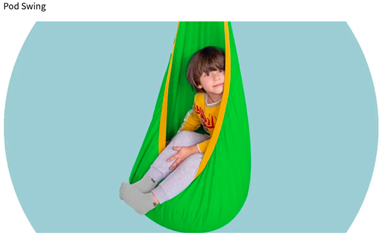Beyond Fidget Spinners: Holiday Gift Ideas to Promote Child Development
Beyond Fidget Spinners: Holiday Gift Ideas to Promote Child Development
Here come the winter holidays, and with it… gifts for the kids! We’ve asked Denise and Maggie, our therapists who specialize in working with children and parents, to bring their expertise to your shopping list. They’ve put their heads together and come up with some great suggestions for intentional holiday gifts - ones that encourage emotional health and connection for kids and the adults in their lives. We hope you find some of these ideas helpful!
Links to the manufacturer websites are provided below; some may also be available on Amazon. Please note that these are not affiliate links, and we’re not partnered with any of these companies. These are genuine, heartfelt suggestions from us to you!
Kids (and pets, and even some adults!) love to camp out in small, cozy spaces for comfort. “Cocooning” can provide a sense of security, safety, and sensory feedback.
The Outree Kids Pod Swing Seat appeals to the sensory-seeking child who loves to spin or swing or the easily dysregulated child who needs a space to reset and decompress. The cotton-canvas hammock swing supports up to 100 pounds of body weight and can be used indoors and outdoors. As the cherry on top, the Pod Swing Seat has a side pocket where kids can store books or fidgets. Installation hardware is included in the package. (www.outree.com)
Play tents are an additional, easily portable option for a calm, soothing space where kids can self-regulate. Children struggling with emotional regulation will benefit from creating a special calm, soothing space. Younger children often enjoy a play tent. Put books, stuffed animals, and a cozy blanket inside for rest time, quiet play, or a calming down space. We especially like this Sea Buddies Play Tent available via MindWare – it sets the stage for an imaginative undersea getaway and evokes warm, beachy vibes during even the coldest months. (www.mindware.com)
Weighted animals and blankets are also a good choice for children and kids who feel anxious sometimes, or who like the feeling of hugs and physical touch.
Great options include Hugz and Warmies include some that can be warmed up as well for additional sensory input. CuddleCalm, available on Etsy, allows you to custom-order plushies weighing between 3-15 pounds.
(www.givehugz.com; www.warmies.com; etsy.com/shop/cuddlecalm)
This Nee Doh Nice Cube is a favorite among the kids, adults, and even some of the therapists at Watermark. This is a fantastic, stress-relieving, mess-free source of sensory feedback that provides ages 3+ the grounding experience of a “super firm squish” when compressed. The kids in our office like this one so much we have to keep buying new ones!
(www.schylling.com)
A coping kit is a great choice that allows them to exercise control and make their own choices. Providing an awesome creative and crafty kit can be a practical and fun toy for kids who use creativity to express and process feelings. We love this Mental Health Kit for kids of all ages. Creative kids might prefer to pick out the items themselves for a customized coping kit.
(Mental Health Kit, www.etsy.com/shop/theimaginativehealer)
Quick card games like this one, created by children’s book author and illustrator Diane Alber, are fun and easy to engage with. The A Little SPOT 101 Get to Know Me Conversation Cards for Kids offers 101 low-pressure prompts to get kids talking. Keep these in your car, purse, or backpack, and play while you wait in a restaurant or run errands. We love to see ordinary life moments, even brief ones, turn into opportunities for connection. (www.dianealber.com)
This Mr. Potato Head-inspired Big Feelings Pineapple playset is a great source of emotional nourishment. The interchangeable facial features correspond to the included chart of common emotions and their expressions. Learning to label feelings with language is one of the single most important tasks of raising emotionally healthy kids that become adults. This cute pineapple gives kids 3 and up lots of opportunities to practice using “feelings words” and interpreting nonverbal facial expressions. And with the adorable little pineapple mirror, children can practice emoting and see how they uniquely express themselves. (Learning Resources, www.learningresources.com)
Have you seen the Taylor “Swiftie” culture craze of DIY craft bracelets? We love the idea of teens customizing their own bracelet designs with messages, names, and even affirmations such as “strength” or “I am enough.” This craft set can promote connection through shared creativity and generosity towards others. A gifted bracelet is a great transitional object – that is, a portable everyday reminder of a loved one’s support and care. Challenge your teen to create matching (or better yet, personalized!) bracelets for their friends, siblings, or extended families. (Available online and at most craft or “big box” stores)
Anyone have a kid that doesn’t stop moving? Active toys like the ANNKIE Dance Mat channel energy into friendly, healthy competition. The battery-powered, two-person dance mat challenges kids (and adults!) to jump, hop, or step onto colorful, flashing arrows while music plays. A remote control adjusts the volume and speed levels. Bluetooth functionality lets you play tunes from you or your teen’s music library on built-in speakers that sync to the dance mat. Want to know more about your teen? Ask them about the music they like – and then challenge them to a dance-off! (Available on Amazon.com)
Journals are a great gift to encourage kids and teens to write down their thoughts - draw them, make us a picture, use words, or even write poetry. We believe that emotional expression is productive and journals with prompts are helpful and fun. Even better, research suggests that handwriting leads to emotional and cognitive processing in ways that typing doesn’t. Although all you really need to journal is a notebook and some privacy; we’ve found some ideas.
Keri Smith’s Wreck This Journal isn't your ordinary journal. Expect prompts that make you think, create things and even (safely) break some rules! It’s unexpectedly fun and a great outlet for big feelings. (www.kerismith.squarespace.com)
A guided journal, such as this Self-Care Journal for Young Adults by social worker Brianna Hollis, can be a great option for your teen who is into developing their identity and learning to care for their mind and body. It’s pretty (“aesthetic” as the kids say!) and has some thoughtful prompts that can help teens overcome writer’s block and get in tune with their needs. (available on Hollis’s Amazon author page)
For the family:
Children working on their interpersonal skills and building social connections might especially benefit from family game nights. We found a few interesting games that balance creativity, activity, and fun.
Turn mealtime into game time with MasterChef! This family cooking game teaches valuable executive function skills, such as planning and time management, while kids learn to whip up delicious, real-life treats. To play, teams compete to prepare one of the 22 included recipes. Mini-challenges within the game, such as prepping ingredients one-handed or completing a blindfolded taste test, spice up the competition. Win or lose, all players earn a tasty prize at the end. The game kit even includes two child-safe knives, making it suitable for ages 7 and up.
Those who get restless during hours-long Monopoly games may have more fun with Abducktion: a weird Strategic Game of Duck Kidnapping. The game challenges you to get your ducks in a row (literally) in patterns depicted on the game cards, so they can be beamed into the UFO! This fast-paced game typically takes about 15-25 minutes and gives kids a chance to practice in-the-moment organization, critical thinking, and decision-making – all key parts of the cognitive skill set we call executive function. Plus, the game pieces are incredibly cute, and we love a good pun. (www.veryspecialgames.com)
The holiday season can place a lot of stress on our schedules, relationships, and finances. We want you to remember that no toy, craft, or trip will ever replace meaningful connection with you. Find time over the holidays to spend one-on-one time with your child – or each child individually if you have more than one. Here’s how:
Set aside 30 minutes and let them be the “play boss.” Just play. That means just let them lead with a topic, activity, or toy. Don’t ask questions or try to teach the child something. Let them lead, and you follow. Be fully present, stay engaged, and put those phones away! This special play time costs zero dollars and has immense value to your child. It gives them a chance to feel special, seen, and delighted in.
We hope you have a great winter season with your children and as a family. Our holiday wish for you is evergreen: may you experience a genuine, deep connection and shared joy with your family and loved ones. Happy Holidays!
- Denise and Maggie















